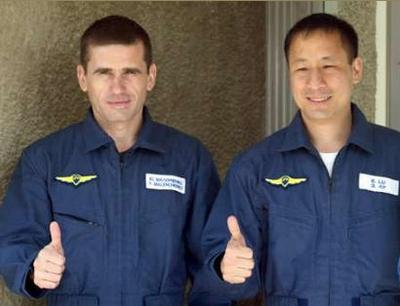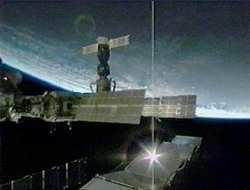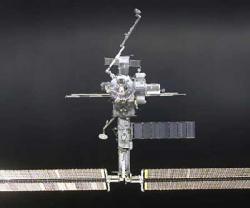Giving Lu and Malenchenko Things To Do
 Boeing engineers have provided a number of studies
to help NASA keep the International Space Station (ISS) viable for
the foreseeable future, relying upon Russian vehicles, Soyuz and
Progress, to transport cargo to the station.
Boeing engineers have provided a number of studies
to help NASA keep the International Space Station (ISS) viable for
the foreseeable future, relying upon Russian vehicles, Soyuz and
Progress, to transport cargo to the station.
Engineers at Boeing NASA Systems in Houston, many from the ISS
Vehicle Integrated Performance and Resources (VIPeR) team, studied
ways to maintain a safe and operable ISS. The team was asked by
NASA immediately after the space shuttle Columbia accident to study
a number of options, taking into account the delay of the unique
cargo ferrying capabilities of the space shuttle.
The Boeing ISS team's primary assessment effort focused on a
smaller ISS crew size and assessed the consumables used by the
station and its crew and the need for spare hardware. The ISS team
is relying upon the Russian vehicles as the only means of
transporting cargo to the ISS until the shuttle returns to flight
and/or the European Space Agency's Automated Transfer Vehicle is
available.

Tracking Food And Water Use
The team tracked the primary consumables used by the station and
its crew and worked closely with NASA's ISS Mission Integration
group. Boeing conducted various analyses to minimize ISS supply and
return requirements while optimizing the ISS vehicle performance
and research.
The VIPeR team first focused on the issue of propellant on board
the station, which is used to keep the ISS in the proper orbit and
orientation and has been one of the most critical consumables in
past studies. They concluded that currently planned Progress
launches would meet propellant re-supply needs.

The next critical consumable is the water necessary to support
the crew and system needs. Each crewmember uses about two kilograms
of water a day for drinking, food and oxygen generation. The team
looked at how water could be brought up while also examining ways
to reduce water needs. "We looked at how long we could leave three
crewmembers up there and when we would go to two crew members,"
said Neil Lemmons, senior systems engineer with the Boeing VIPeR
team.
"Without the space shuttle, it was quickly determined by all
involved that a three person crew could not be sustained," said Bob
Korin, manager of the Boeing VIPeR team. Keeping a crew on the ISS
was important, he added, because it would "give us a set of eyes,
hands and creative thinking capability to respond to things that
arise."
More Than A Maintenance Crew?
 Although there would be some limits, a two-person crew could
also continue to do scientific research. The Boeing teams,
including a strong effort by the safety community, looked at the
risks associated with a smaller two-person crew and concluded that
there were no significant safety concerns. A two- person crew not
only keeps research going but also maintains support for
preventative and corrective maintenance, anomaly investigation and
response, and other ISS System Operations needs that can best be
done by an on-orbit crew.
Although there would be some limits, a two-person crew could
also continue to do scientific research. The Boeing teams,
including a strong effort by the safety community, looked at the
risks associated with a smaller two-person crew and concluded that
there were no significant safety concerns. A two- person crew not
only keeps research going but also maintains support for
preventative and corrective maintenance, anomaly investigation and
response, and other ISS System Operations needs that can best be
done by an on-orbit crew.
Boeing and NASA engineers have studied the impact of a
two-person crew on future science research. "The focus has been on
new samples and consumables for the science and research apparatus
already on board the ISS that require minimal space and weight,"
said Rick Golden, program manager of ISS payload integration.
"Our group (Boeing and its subcontractors, Teledyne Brown
Engineering and United Space Alliance) ensures that interfaces
between the science experiments and the space station are
compatible," said Golden.
"A lot of our focus has been working the safety aspects to fly
U.S. payload hardware on Soyuz and Progress launches," Golden
explained. "We are positioning a select number of payloads at the
Baikonur launch site in order to be able to take advantage of any
space that becomes available on the upcoming Progress flights."

The Boeing ISS team reassessed the manifests for several planned
shuttle launches. "We had to support system maintenance which may
have required changing out filters, valves, bags and things along
those lines or other items to support system repair," said
Korin.
The team came up with a prioritized shopping list and looked at
what they could take up without the space shuttle. The NASA/Boeing
ISS team evaluated the amount of propellant, water, gas, and dry
cargo that is needed to the support the ISS and its crew. The ISS
subsystem teams, including the logistics and maintenance team,
played a critical role in defining the shopping list of needed
items.
 The
Environmental Control and Life Support System group identified the
selector valve and filter for the Carbon Dioxide Removal Assembly
and the Internal Thermal Control System group identified the Pump
Package Assembly as essential spares to be manifested on the
upcoming Russian Soyuz and Progress flights.
The
Environmental Control and Life Support System group identified the
selector valve and filter for the Carbon Dioxide Removal Assembly
and the Internal Thermal Control System group identified the Pump
Package Assembly as essential spares to be manifested on the
upcoming Russian Soyuz and Progress flights.
The Soyuz is the ISS crew escape vehicle used in case of
emergency and is certified for 200 days of life and is rotated
every 180 to 190 days. They are normally taken to ISS by a "taxi
crew" who then bring the "old" one back. The Progress vehicle is
unmanned and carries crew supplies and hardware spares to help
maintain the life of ISS. There are normally 3 Progress flights a
year.
"The Russians have given us about 30 kg allocation for US items
to be launched on Soyuz 6S, so we have been working very hard with
NASA to make sure all these items are certified to be launched on a
Russian vehicle, and the Russians properly stow them for launch,"
according to Ray V. Gonzales, Boeing launch package manager for
Russian vehicles. "We are also working to get these items to Moscow
and then to Baikonur, Khazakstan where they will be launched."
 Classic Aero-TV: The Switchblade Flying Car FLIES!
Classic Aero-TV: The Switchblade Flying Car FLIES! ANN FAQ: Q&A 101
ANN FAQ: Q&A 101 ANN's Daily Aero-Term (04.12.24): Discrete Code
ANN's Daily Aero-Term (04.12.24): Discrete Code ANN's Daily Aero-Term (04.13.24): Beyond Visual Line Of Sight (BVLOS)
ANN's Daily Aero-Term (04.13.24): Beyond Visual Line Of Sight (BVLOS) ANN's Daily Aero-Linx (04.13.24)
ANN's Daily Aero-Linx (04.13.24)








